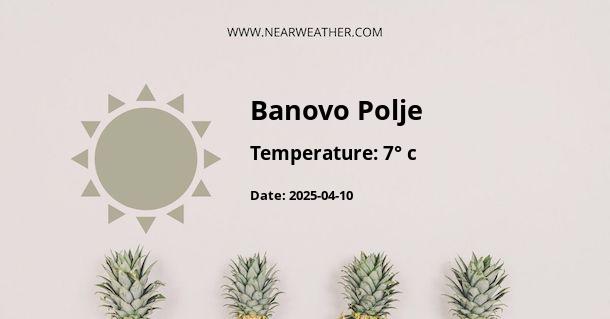Introduction to Banovo Polje, Republika Srpska
Banovo Polje is a locality situated in Republika Srpska, Bosnia and Herzegovina. Understanding its climate patterns and weather nuances is crucial for residents, travelers, and businesses operating in the region. With continental influences, the area experiences a temperate climate that exhibits all four distinct seasons—spring, summer, autumn, and winter—each bringing its own weather patterns.
Overview of Banovo Polje's Climate
The climate in Banovo Polje can be broadly characterized as humid continental (Köppen climate classification: Dfa/Dfb), common for many regions in the interior of the European continent. This entails warm to hot summers and cold winters, with a significant temperature difference between the hottest and coldest months.
Seasonal Weather Patterns
- Spring: Spring in Banovo Polje is a time of transition, with temperatures gradually rising and the snow from winter starting to melt, leading to higher water levels in local rivers and streams.
- Summer: During the summer, the region often experiences warm and sometimes humid weather, with temperatures occasionally peaking above 30°C (86°F).
- Autumn: The fall brings cooler temperatures and increased precipitation, setting the stage for wintry weather.
- Winter: Winter is characterized by cold temperatures that often dip below freezing, alongside snowfall and icy conditions.
Detailed Seasonal Analysis
Spring (March to May)
Spring is a period of rebirth and renewal, as the cold and snow give way to milder temperatures and longer days.
Annual average precipitation in spring: Approximately 100-150 mm per month
Average temperatures: 5°C (41°F) in March to 15°C (59°F) in May
Summer (June to August)
Summers give rise to outdoor activities, with conditions that are generally favorable for agriculture and tourism.
Peak average temperatures: 25°C (77°F) to 30°C (86°F)
Precipitation: Monthly averages between 80-100 mm
Autumn (September to November)
As the lush greenery wears a coat of autumnal hues, the region experiences a drop in temperatures and an increase in rainy days, leading towards the chill of winter.
Precipitation increases in late autumn, contributing to foggy conditions.
Temperatures range from 10°C (50°F) in September to 4°C (39°F) by November.
Winter (December to February)
Winter is marked by a blanket of snow covering the landscape, an allure for winter sports enthusiasts, albeit posing challenges for transportation and daily life.
Heavy snowfalls range from 200 mm to 400 mm cumulatively.
Temperatures often reside between -5°C (23°F) to 0°C (32°F), though colder spells can occur.
Temperature and Precipitation Charts
To gain a better understanding of Banovo Polje's climate, let's delve into the details depicted in temperature and precipitation charts. These charts are essential for farmers planning their crop cycles, event planners, construction projects, and more.
| Month | Average High (°C) | Average Low (°C) | Precipitation (mm) |
|---|---|---|---|
| January | 1 | -6 | 60 |
| February | 3 | -4 | 55 |
| March | 10 | 0 | 50 |
| April | 16 | 6 | 60 |
| May | 21 | 11 | 80 |
| June | 24 | 14 | 90 |
| July | 27 | 15 | 70 |
| August | 27 | 15 | 80 |
| September | 22 | 10 | 85 |
| October | 16 | 6 | 70 |
| November | 9 | 2 | 85 |
| December | 3 | -3 | 75 |
Extreme Weather Events and Climate Changes
Banovo Polje, like many other regions, is not immune to extreme weather conditions and the broader impacts of climate change. Recent patterns indicate variances in precipitation and unpredictable temperature swings, which can lead to natural disasters like floods and droughts, affecting agriculture, infrastructure, and human settlements.
Expert opinions suggest that weather extremes might become more frequent and intense in the coming years, emphasizing the need for climate resilience and adaptation strategies.
Long-term Climate Trends
Decadal climate records for Banovo Polje show subtle but consistent shifts in long-term weather patterns. Meteorologists and climate scientists have been tracking data to predict potential future climates and prepare accordingly. This involves analyzing historical weather data to discern any significant trends.
Weather Preparedness and Adaptation Strategies
Weather preparedness is essential for community safety and economic stability in Banovo Polje. This includes building robust infrastructure, creating effective early warning systems, and educating residents on how to respond to severe weather events.
- Infrastructure should be designed to withstand extreme weather, from heavy snowfalls to intense summer storms.
- Early warning systems for floods and other natural disasters can help mitigate risk and safeguard lives and property.
- Community education programs can teach individuals how to prepare for and react to different weather conditions, from securing homes during wind storms to safe driving practices in winter conditions.
Conclusion
In sum, Banovo Polje embodies a climate that is typically continental, showcasing seasonal variability with cold winters and warm summers. Adaptation to climate change and extreme weather patterns remain pivotal for the sustainable development of the region. Continuous monitoring and research are vital to understand and predict weather pattern changes, henceforth, offering guidance for necessary adaptations in urban planning, agriculture, and emergency response strategies.
A - Banovo Polje's Latitude is 44.911388 & Longitude is 19.446939.
A - Weather in Banovo Polje is 7° today.
A - Climate Conditions in Banovo Polje shows overcast clouds today.
A - Humidity in Banovo Polje is 51% today.
A - Wind speed in Banovo Polje is 17.03 km/h, flowing at 336° wind direction. today.
